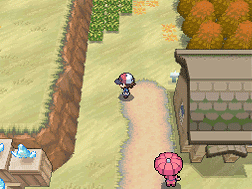Season (game mechanic)
- If you were looking for the division of dubbed episodes, see season.
| January is spring | |||
|---|---|---|---|
Spring |
Summer | ||
Autumn |
Winter | ||
| 14 days until summer! | |||
Seasons are a mechanic of the Pokémon games. The concept was introduced in Generation V with Pokémon Black and White.
Much as Generation II introduced time and days of the week to the Pokémon series, and Generation IV used the Nintendo DS's internal clock to keep track of the date of capture of a particular Pokémon, seasons are a new feature introduced in Generation V. Unlike in the real world, where each season lasts for approximately three sequential months, the seasons in Unova will change each month, going through the full cycle of spring, summer, autumn, and winter three times per year.
Effects
Deerling and its evolution Sawsbuck are known to change forms with the seasons.
In some areas, the wild Pokémon will vary from season to season. For example, Shelmet is very common in the summer, but rare in the winter. The only places this occurs are Route 8, Moor of Icirrus, Dragonspiral Tower and Undella Bay.
Some areas are only accessible in a given season. The background music on most routes changes slightly depending on the season.
List of seasons
Spring
Springtime weather appears in January, May, and September. Certain areas may have rainy weather.
Summer
Summer weather appears in February, June, and October. Morning begins one hour earlier, at 3:00 AM, while Day lasts an hour longer, until 8:59 PM.
Autumn
Autumn weather appears in March, July, and November.
Winter
Winter weather appears in April, August, and December. Morning begins one hour later, at 7:00 AM, while Day lasts an hour shorter, until 6:59 PM. Due to snow piling up, certain areas can be accessed that are normally inaccessible.
Trivia
- As February is included among the months considered as summer, it is the shortest season on average. Where the other seasons each last a total of 92 days in a real-time year, summer lasts a total of 89 days or, in case of a leap year, 90 days.
- Interestingly, this is true for the southern hemisphere summer, as the Earth is near perihelion. Summer lasts only approximately 89 days, while winter lasts closer to 94. The opposite is in effect for the northern hemisphere.
- When summer and winter start in the northern hemisphere of the real world, the same season is in effect in-game. This is not true for spring and autumn, whereas it is spring in-game when autumn starts in real life and vice versa.
- The opposite is true for the southern hemisphere: real-world spring and autumn start in months with their respective in-game seasons, while summer and winter start in in-game winter and summer respectively.
- In some countries, most notably in North America and parts of Europe, seasons start at solstices and equinoxes, rather than starting at the first day of a month as is the case in countries like Australia. In such cases, all four seasons appear in-game in each real life season.
- Black and White, the first games to introduce this feature, were released during autumn in Japan, and the in-game season was spring. The international releases were released in what is generally considered to be spring in the northern hemisphere, and the in-game season was autumn.

|
This game-related article is part of Project Games, a Bulbapedia project that aims to write comprehensive articles on the Pokémon games. |

